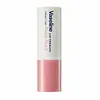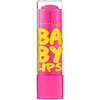What's inside
What's inside
 Key Ingredients
Key Ingredients

 Benefits
Benefits

 Concerns
Concerns

 Ingredients Side-by-side
Ingredients Side-by-side

Caprylic/Capric Triglyceride
MaskingDiisostearyl Malate
EmollientHydrogenated Polyisobutene
EmollientSynthetic Wax
AbrasiveBis-Diglyceryl Polyacyladipate-2
EmollientButyrospermum Parkii Butter
Skin ConditioningMicrocrystalline Wax
Emulsion StabilisingPolyglyceryl-2 Triisostearate
EmulsifyingPetrolatum 3%
EmollientSilica
AbrasiveSilica Dimethyl Silylate
EmollientTitanium Dioxide
Cosmetic ColorantSorbitan Isostearate
EmulsifyingCI 77491
Cosmetic ColorantCI 77492
Cosmetic ColorantCI 15850
Cosmetic ColorantCI 42090
Cosmetic ColorantParfum
MaskingLinalool
PerfumingBenzyl Benzoate
AntimicrobialPentaerythrityl Tetra-Di-T-Butyl Hydroxyhydrocinnamate
AntioxidantDehydroacetic Acid
PreservativeAlumina
AbrasiveWater
Skin ConditioningLimonene
PerfumingHexyl Cinnamal
PerfumingButylene Glycol
Humectant1,2-Hexanediol
Skin ConditioningHoney Extract
HumectantPrunus Persica Fruit Extract
AbrasiveBHT
AntioxidantPhenoxyethanol
PreservativeEthylhexylglycerin
Skin ConditioningCaprylic/Capric Triglyceride, Diisostearyl Malate, Hydrogenated Polyisobutene, Synthetic Wax, Bis-Diglyceryl Polyacyladipate-2, Butyrospermum Parkii Butter, Microcrystalline Wax, Polyglyceryl-2 Triisostearate, Petrolatum 3%, Silica, Silica Dimethyl Silylate, Titanium Dioxide, Sorbitan Isostearate, CI 77491, CI 77492, CI 15850, CI 42090, Parfum, Linalool, Benzyl Benzoate, Pentaerythrityl Tetra-Di-T-Butyl Hydroxyhydrocinnamate, Dehydroacetic Acid, Alumina, Water, Limonene, Hexyl Cinnamal, Butylene Glycol, 1,2-Hexanediol, Honey Extract, Prunus Persica Fruit Extract, BHT, Phenoxyethanol, Ethylhexylglycerin
Polybutene
Octyldodecanol
EmollientIsopropyl Myristate
EmollientPetrolatum
EmollientEthylhexyl Methoxycinnamate
UV AbsorberPolyethylene
AbrasiveOzokerite
Emulsion StabilisingEthylhexyl Salicylate
UV AbsorberButyrospermum Parkii Butter
Skin ConditioningDiisostearyl Malate
EmollientCandelilla Cera
EmollientVp/Hexadecene Copolymer
Silica Dimethyl Silylate
EmollientParfum
MaskingCalcium Aluminum Borosilicate
Pentaerythrityl Tetra-Di-T-Butyl Hydroxyhydrocinnamate
AntioxidantTocopherol
AntioxidantTocopheryl Acetate
AntioxidantAlumina
AbrasiveAroma
Silica
AbrasiveIsopropyl Palmitate
EmollientPentaerythrityl Tetraisostearate
EmollientLimonene
PerfumingSynthetic Fluorphlogopite
Calcium Sodium Borosilicate
Benzyl Benzoate
AntimicrobialCentella Asiatica Extract
CleansingAluminum Hydroxide
EmollientCitral
PerfumingLinalool
PerfumingHexyl Cinnamal
PerfumingTin Oxide
AbrasiveGeraniol
PerfumingEugenol
PerfumingAloe Barbadensis Extract
Skin ConditioningMel
EmollientCalcium Pantothenate
Ascorbic Acid
AntioxidantDimethicone
EmollientSodium Chondroitin Sulfate
Skin ConditioningAtelocollagen
Skin ConditioningCI 77891
Cosmetic ColorantMica
Cosmetic ColorantCI 45410
Cosmetic ColorantCI 77491
Cosmetic ColorantCI 77492
Cosmetic ColorantCI 77499
Cosmetic ColorantCI 15850
Cosmetic ColorantCI 45380
Cosmetic ColorantCI 19140
Cosmetic ColorantCI 42090
Cosmetic ColorantCI 15985
Cosmetic ColorantCI 75470
Cosmetic ColorantPolybutene, Octyldodecanol, Isopropyl Myristate, Petrolatum, Ethylhexyl Methoxycinnamate, Polyethylene, Ozokerite, Ethylhexyl Salicylate, Butyrospermum Parkii Butter, Diisostearyl Malate, Candelilla Cera, Vp/Hexadecene Copolymer, Silica Dimethyl Silylate, Parfum, Calcium Aluminum Borosilicate, Pentaerythrityl Tetra-Di-T-Butyl Hydroxyhydrocinnamate, Tocopherol, Tocopheryl Acetate, Alumina, Aroma, Silica, Isopropyl Palmitate, Pentaerythrityl Tetraisostearate, Limonene, Synthetic Fluorphlogopite, Calcium Sodium Borosilicate, Benzyl Benzoate, Centella Asiatica Extract, Aluminum Hydroxide, Citral, Linalool, Hexyl Cinnamal, Tin Oxide, Geraniol, Eugenol, Aloe Barbadensis Extract, Mel, Calcium Pantothenate, Ascorbic Acid, Dimethicone, Sodium Chondroitin Sulfate, Atelocollagen, CI 77891, Mica, CI 45410, CI 77491, CI 77492, CI 77499, CI 15850, CI 45380, CI 19140, CI 42090, CI 15985, CI 75470
 Reviews
Reviews

Ingredients Explained
These ingredients are found in both products.
Ingredients higher up in an ingredient list are typically present in a larger amount.
Alumina is another name for the compound aluminum oxide. It is used as a thickener, absorbent, and abrasive.
As an absorbent, alumina can give a mattifying effect. It is used in mineral sunscreens to help coat nano-sized filters, such as titanium dioxide. By increasing the size of the UV filters, these ingredients stay on the skin for a longer time. By coating small sized ingredients, alumina helps thicken a product.
Alumina may be used as an abrasive, or exfoliant.
Alumina is naturally occurring in the mineral corundum. Certain varieties of corundum create rubies and sapphires. Corundum is also the crystalline form of alumina.
Learn more about AluminaBenzyl Benzoate is usually created from the condensation of benzoic acid and benzyl alcohol. It is used as a preservative, solvent, and has a floral/balsamic scent in large amounts.
As a preservative, Benzyl Benzoate works against bacteria and fungus. It is often used to treat scabies and lice in medicine.
Solvents are used to keep ingredients together in a product. They can help dissolve ingredients to stable bases or help evenly distribute ingredients throughout the product.
Due to its fragrance, Benzyl Benzoate can be sensitizing and may cause contact dermatitis. It is a known EU allergen. We recommend speaking with a professional if you have any concerns.
Benzyl Benzoate can be naturally found in cranberries and peaches.
Learn more about Benzyl BenzoateThis ingredient is also known as shea butter. It is an effective skin hydrator and emollient.
Emollients help soothe and soften your skin. It does this by creating a protective film on your skin. This barrier helps trap moisture and keeps your skin hydrated. Emollients may be effective at treating dry or itchy skin.
Shea butter is rich in antioxidants. Antioxidants help fight free-radicals, or molecules that may harm the body. It is also full of fatty acids including stearic acid and linoleic acid. These acids help replenish the skin and keep skin moisturized.
While Shea Butter has an SPF rating of about 3-4, it is not a sunscreen replacement.
Shea butter may not be fungal acne safe. We recommend speaking with a professional if you have any concerns.
Learn more about Butyrospermum Parkii ButterCi 15850 is the pigment color red. It is an azo dye and created synthetically.
Azo dyes need to be thoroughly purified before use. This allows them to be more stable and longer-lasting.
This ingredient is common in foundations, lipsticks, and blushes. This color is described as brown/orangey red.
It has many secondary names such as Red 6 and Red 7. According to a manufacturer, Red 6 usually contains aluminum.
Learn more about CI 15850Ci 42090 is a synthetic dye created from petroleum. It is used to give a bright blue color to cosmetics, medicine, and food.
Ci 77491 is also hydrated iron III oxide. It's sole purpose is to give a red/pink hue to products.
Iron III oxides are classified as inorganic chemicals for coloring.
Synthetically created Ci 77491 is considered safer than those naturally found. This is because the synthetically created version may contain less impurities. Iron oxides are generally non-toxic and non-allergenic.
Learn more about CI 77491Ci 77492 is also hydrated iron III oxide. It's sole purpose is to give a yellow hue to products.
Iron III oxides are classified as inorganic chemicals for coloring.
Synthetically created Ci 77492 is considered safer than those naturally found. This is because the synthetically created version may contain less impurities. Iron oxides are generally non-toxic and non-allergenic.
Learn more about CI 77492Diisostearyl Malate is an emollient and most often used in lip products. It comes from isostearyl alcohol, a fatty acid, and malic acid, an AHA.
As an emollient, Diisostearyl Malate helps create a thin film on your skin to trap moisture in. This helps keep your skin soft and smooth.
Hexyl Cinnamal is a fragrance ingredient with a similar scent to jasmine. It can be naturally found in chamomile essential oil.
This ingredient is a known EU allergen and may sensitize the skin. The EU requires this ingredient to be listed separately on an ingredients list.
Hexyl Cinnamal is not water soluble but is soluble in oils.
Learn more about Hexyl CinnamalLimonene is a fragrance that adds scent and taste to a formulation.
It's found in the peel oil of citrus fruits and other plants such as lavender and eucalyptus. The scent of limonene is generally described as "sweet citrus".
Limonene acts as an antioxidant, meaning it helps neutralize free radicals.
When exposed to air, oxidized limonene may sensitize the skin. Because of this, limonene is often avoided by people with sensitive skin.
The term 'fragrance' is not regulated in many countries. In many cases, it is up to the brand to define this term. For instance, many brands choose to label themselves as "fragrance-free" because they are not using synthetic fragrances. However, their products may still contain ingredients such as essential oils that are considered a fragrance.
Learn more about LimoneneLinalool is a fragrance and helps add scent to products. It's derived from common plants such as cinnamon, mint, citrus, and lavender.
Like Limonene, this ingredient oxidizes when exposed to air. Oxidized linalool can cause allergies and skin sensitivity.
This ingredient has a scent that is floral, spicy tropical, and citrus-like.
Learn more about LinaloolParfum is a catch-all term for an ingredient or more that is used to give a scent to products.
Also called "fragrance", this ingredient can be a blend of hundreds of chemicals or plant oils. This means every product with "fragrance" or "parfum" in the ingredients list is a different mixture.
For instance, Habanolide is a proprietary trade name for a specific aroma chemical. When used as a fragrance ingredient in cosmetics, most aroma chemicals fall under the broad labeling category of “FRAGRANCE” or “PARFUM” according to EU and US regulations.
The term 'parfum' or 'fragrance' is not regulated in many countries. In many cases, it is up to the brand to define this term.
For instance, many brands choose to label themselves as "fragrance-free" because they are not using synthetic fragrances. However, their products may still contain ingredients such as essential oils that are considered a fragrance by INCI standards.
One example is Calendula flower extract. Calendula is an essential oil that still imparts a scent or 'fragrance'.
Depending on the blend, the ingredients in the mixture can cause allergies and sensitivities on the skin. Some ingredients that are known EU allergens include linalool and citronellol.
Parfum can also be used to mask or cover an unpleasant scent.
The bottom line is: not all fragrances/parfum/ingredients are created equally. If you are worried about fragrances, we recommend taking a closer look at an ingredient. And of course, we always recommend speaking with a professional.
Learn more about ParfumPentaerythrityl Tetra-Di-T-Butyl Hydroxyhydrocinnamate (long name, huh?) is a synthetic antioxidant.
It is used to help stabilize other antioxidants or prevent the color from changing in a product.
As an antioxidant, it helps fight free-radical molecules. Free-radical molecules are capable of damaging our cells and other genetic material. Thus, antioxidants may reduce the signs of aging.
This ingredient is oil-soluble.
Learn more about Pentaerythrityl Tetra-Di-T-Butyl HydroxyhydrocinnamatePetrolatum is more commonly known as petroleum jelly. It is created by mixing waxes and mineral oils.
This ingredient is effective at reducing water loss by 99%. This is because it is an occlusive. Occlusives create a hydrophobic barrier on the skin to prevent evaporation. This property makes it great for hydrating dry skin.
Pro tip: Use occlusives, such as this ingredient, on damp skin for the best results.
The quality or origin of petrolatum is only known when disclosed by the brand. Most cosmetic petrolatum has gone through several purification stages.
Another benefit of occlusives is it protects your skin against infection or allergies.
Petrolatum may not be safe for fungal-acne. Studies show mineral oil / petroleum leads to the growth of M. Furfur, a type of yeast.
Learn more about PetrolatumSilica, also known as silicon dioxide, is a naturally occurring mineral. It is used as a fine, spherical, and porous powder in cosmetics.
Though it has exfoliant properties, the function of silica varies depending on the product.
The unique structure of silica enhances the spreadability and adds smoothness, making it a great texture enhancer.
It is also used as an active carrier, emulsifier, and mattifier due to its ability to absorb excess oil.
In some products, tiny microneedles called spicules are made from silica or hydrolyzed sponge. When you rub them in, they lightly polish away dead skin layers and enhance the penetration of active ingredients.
Learn more about SilicaThis silica is mainly used to thicken oils and suspend particles in oils. It is not water soluble.
According to the manufacturer, it:
The manufacturer also claims this ingredient to be useful in makeup.
In lipstick formulations, this ingredient improves color payoff, reduces pigment settling, and reduces oil bleeding. This ingredient also improves the grip of powder products such as dry shampoos.
Learn more about Silica Dimethyl Silylate